Edmund Brookes
November 2010
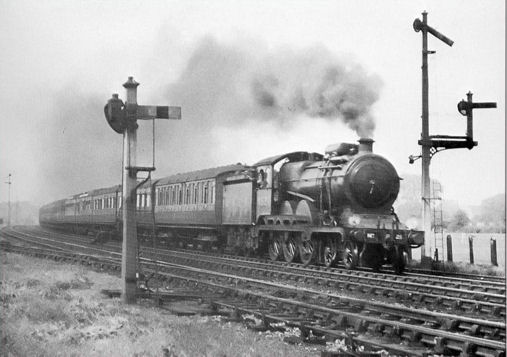
This history of the railways of Trumpington is based on a presentation given to the Local History Group on 25 November 2010 and documents the state of the local railway network at that time. There is an updated version of this page, Railways and Trumpington, 1845-2019. See Railways for a general introduction to railways in Trumpington.
Introduction
Trumpington now has and always had no railway station, but you may be surprised to learn that it did have one (albeit temporarily for 1 week) and three pre-grouping (i.e. pre-1923) railway companies did run through or alongside the parish. This paper explores the history of Trumpington’s railways and at least one tramway and three garden railways, of which two are extant.
First I must explain some key dates in British railway history. There are essentially four epochs.
Pre-1923: Before 1923 the standard gauge railways of Great Britain were all independent (after initial amalgamations), with many having running rights over other companies tracks (this affected Trumpington’s railways where the Great Northern Railways had running powers over the Great Eastern Railway from 100 yards east of Shepreth and the London & North Western Railway (the Midland also from Huntingdon East) had running powers into Cambridge Station.
1923-1948: After the Great War, the railways were in a very parlous state as they had been under state control and thrashed mercilessly to carry all the cargoes (human and freight) that were necessary between 1914 and 1918 for the Allies to win the war. Totally inadequate compensation from the Government (paltry is a kind word) in no way covered the reparations necessary, the true cost which exhibited itself in a lack of maintenance and a run down of the assets. The Government brought in a Bill which forced them to combine into four big companies. Of these, the London & North Eastern Railway (LNER) and the London Midland & Scottish Railway (LMSR) served Cambridge. It is ironic that before the Great War, Parliament had obstructed attempts by the companies themselves to combine.
1948-1994: The nationalisation era. The ‘Big Four’ were very run down after inadequate compensation for the havoc World War II caused to the railways and were nationalised in 1948.
1994- the present: The privatisation era.
Bacon’s New Survey Map of Northampton, Huntingdon, Cambridge and Bedford (pre-1923) shows the eastern boundary of Trumpington as Hills Road as far north as Homerton College, where it strikes west to Hobson’s Brook and then north to the River Cam. Trumpington was then part of Chesterton Rural District Council and I have used this area definition in this paper.
The First and Second Railways
The first two railways (what are effectively the Great Eastern and Great Northern routes to London) have been quite closely connected for most of their history but in the very early days this was not so. Bearing in mind that the Stockton & Darlington Railway was only opened in 1825, in that year there was an epidemic of Railway Fever. In that year Messr Rennies made a survey for a line northwards from London, up the Lea Valley and then by the valleys of the Rib and Quinn and the ‘towns’ of Braughing and Barkway to Cambridge. The plan stopped there but was extended directly to Lincoln and York in 1827. In 1835 Mr Joseph Gibbs (a clever and sanguine engineer) projected a line from London (Whitechapel) to York via Dunmow, Cambridge and Lincoln. The Board of Trade Commissioners did not find favour with this but preferred a route via Derby and Rotherham which would be more remunerative. Hudson, the manipulative Railway King, was still keen to see Cambridge on the main route to the north which from the “Cambridge and York” became the “London and York” (the eventually built route which became the GNR) (Grinling, 1898). What follows is very much a synthesis of a complex battle of intrigue and subterfuge which led to two routes to Cambridge.
Nevertheless I will consider the arrival of the two lines as part of one group (which they eventually formed in 1923).
The Northern & Eastern Railway (later the Great Eastern Railway)
We nearly had the first Cambridge station in the parish. The Northern and Eastern Railway Act received Royal Assent on 4 July 1836, so it was quite an old railway. Bear in mind that the Liverpool & Manchester Railway was only opened in 1830. The Northern & Eastern Railway (N&E) was to build a railway from London to Norwich as what is now the main route to Norwich through Colchester was only slowly being built and piecemeal. The Act specified that Cambridge Station should be “on the south side of the river Cam near a certain farm house called Eddleston Farm in the Parish of Trumpington, and to communicate with the town of Cambridge by a branch road to join the London to Cambridge turnpike road at or near Leys and Cow Common in the parish of Little St Mary, Cambridge”. Fellows suggests that location was probably near the old farm house (River Farm) (Grinling, 1898, page 9). Construction of what is effectively the Liverpool Street Line did not progress smoothly, as was the case with many railways then. To save money the N&E Railway actually started at Stratford using what are still called the Cambridge Platforms, before a cut off to Hackney was built years later. This accounts for the right hand swing these days at Coppermill Junction onto the Chingford Line, although the original mainline is now gaining increasing importance as a route to Docklands and it runs right through the Olympic site. Construction did not begin until 1840 and it was opened in stages to Bishops Stortford which was reached on 16 May 1842 where an 1840 Act permitted the abandonment of the route north.
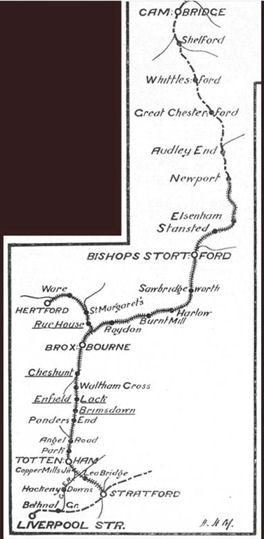
The N&E was actually built to a gauge of 5’0″, compared with the then narrow (now standard) gauge of 4’8½” (compared with Brunel’s Broad Gauge of 7’0¼”) as it ran from Stratford to Shoreditch over the tracks of the Eastern Counties Railway (ECR) which went to Colchester (and never reached Norwich as it ran out of money). After much skulduggery the N&E set off north again and in 1843 secured an Act to extend to Newport, Essex. Later that year the ECR took a 999 year lease on the N&E which continued until the latter was dissolved in 1902. The ECR obtained powers on 4 July 1844 to extend from Newport to Brandon to link up with the East Anglian Railway to Norwich with a branch from Ely to meet the London & Birmingham Railway at Peterborough (East). It was converted to standard gauge in late 1844 and was formally opened through to Norwich (Trowse) on 29 July 1845.
In the early days, the service to London and through the parish was not very good and indeed deteriorated after opening, taking nearly 2 hours to London. This was obviously a great improvement on a stagecoach though. The East Anglian railways came together as the Great Eastern Railway in 1868 and Liverpool Street Station was opened in 1874. From 1870 to 1917 a number of Cambridge Line trains, including those through trains from Doncaster and York worked to London St Pancras over the Tottenham and Hampstead Junction Railway (T&HJ), partly to avoid the congestion at Bishopsgate and also for convenience for the West End (remember the first Underground railway opened from Paddington through Kings Cross to Farringdon in 1863). You can still see the site of the curve south of Tottenham Hale station adjacent to the old paper works and under the bridge which takes the T&HJ over where southbound trains diverted. Most trains only stopped a couple of times at the maximum to Cambridge and some slipped a carriage at Broxbourne for Hertford East.

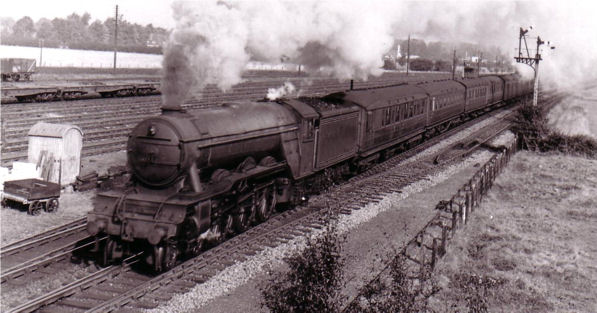
Traffic from Cambridge to and from Colchester was worked on the line, often by the ubiquitous Class E4 2-4-0 Locomotives, almost up until the line was closed.
I will not dwell on the trials and tribulations of the siting of Cambridge Station where it now is, but years ago it did have a second platform (Grinling, 1898, page 13) so the current proposal for new island platforms to be numbered 7 and 8 is nothing new!
The Great Northern Railway
The London & York Railway had opened from Peterborough to Maiden Lane (effectively Kings Cross Goods Shed where the Channel Tunnel Rail Link now goes over the line) in 1850 and had become the Great Northern Railway (GNR). It had set its eyes on Cambridge and an idea for a 73 mile single track railway from Oxford to Cambridge in 1846 emerged as the 13 mile Royston and Hitchin Railway (R&H). The GNR saw the potential to attack Cambridge and an 1847 Act sanctioned a lease on completion, although an extension to a separate Cambridge station was rejected. The line opened to Royston on 21 October 1850 and was extended to Shepreth on 1 August 1851. From there it ran five daily omnibuses to Cambridge! Concurrently (but after much prevarication) the ECR put in hand the construction of it’s Shelford to Shepreth branch (as a single track) which also opened on 1 August 1851. It actually terminated a couple of hundred yards east of the R&H Shepreth Station! A Third Class through fare was 5/-. The GNR offices were at 23 Trinity Street, Cambridge.
In the next section I refer to attempts by the GNR to secure its own line right through to Cambridge as the two parties, the ECR and the GNR, were not on the best of terms, but on 1 April 1852 common sense prevailed and an end on junction was laid. However, the GNR stopped running its (loss making) coaches and the ECR assumed a lease of the R&H and thereby ran trains from Cambridge to Hitchin, but would not allow GNR trains from London to run to Cambridge. In the next section we will read about the building of the Bedford line, but the political implications associated with this and the possibility of GNR trains approaching Cambridge via Sandy led to an 1864 Act in which the ECR ceded running powers over its now double track line to Shepreth to the GNR which promptly assumed responsibility for the services and quick through trains to London. Incidentally, this is the reason that the old signal box and still the junction at Shelford are known as “Shepreth Branch Junction”.
So by 1868 the pattern of services on the main line south was established with trains to both London Liverpool Street and Kings Cross. Kings Cross trains usually started and terminated in Platform 2 at Cambridge Station, as working through to Kings Lynn only started in the 1990s with electrification. The reason for this change was firstly that it was quicker (despite being longer) and to relieve pressure on the line down the Lea Valley as Stansted Airport traffic assumed greater importance. When I have been commuting to London, the presence of two high quality routes has meant that I have hardly even failed to get to London.
That then is the story of how the current railway along the eastern boundary of the parish arrived.
The Third Railway: The London & North Western Railway
We have read already about the London & Birmingham Railway at Peterborough. It amalgamated with other lines such as the Grand Junction to form the London & North Western Railway which in the 19th century was not only the most powerful railway in the land but also one of the largest Joint Stock Companies in the world!
The Bedford & Cambridge Railway (B&C) started as a local railway between Sandy and Potton, promoted privately by Captain Sir William Peel, and opened to freight on 23 June 1857 and passengers in April 1858. The B&C began passenger services to Cambridge on 7 July 1862 and was absorbed by the LNWR in 1865. The LNWR and the GNR then enjoyed very cordial relations (then known as the Euston Confederacy which was effectively a cartel run by Captain Huish the dictator Chairman of the LNWR which dictated who and when it did business with). It was this friendship which enabled the GNR to put very heavy pressure on the ECR to give it access to Cambridge over the Shepreth Branch referred to above. At one time the GNR contemplated its own line from Shepreth through Haslingfield to join the B&C about 3 miles west of Cambridge at Lords Bridge, and then to its own terminus near Christ’s Pieces.
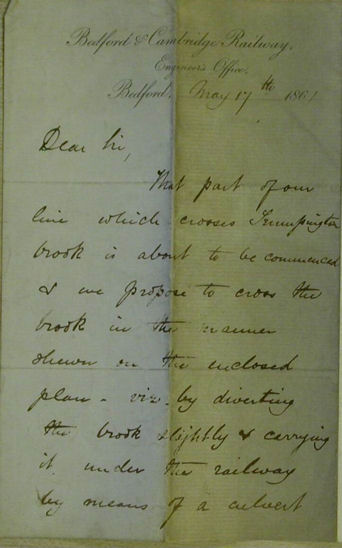
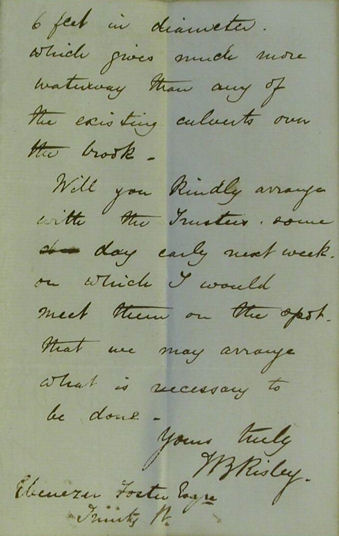
The politics surrounding the Act of Parliament for the Bedford & Cambridge Railway, its purchase of the Sandy & Potton, and the agreement by the ECR to allow the GNR to use the Shepreth Branch are detailed in Fellows (1976). The Act of Parliament allowed for a separate station in Cambridge, roughly where Pordige’s warehouse used to be and in what became the LNWR goods yard. However, by the time it came to build the station relations with the ECR had improved and it was agreed to make a small contribution to the enlarged Cambridge Station then being rebuilt by the ECR.
The railway was always bridged by Long Road whereas the ECR had a level crossing. The original bridge is shown in Fellows (1976, page 140). Reference has often been made to a Coprolite Siding and it did exist, but its site remains a mystery. Railway Magazine of January 1918 quotes “Readers will be interested to know that a 0-6-0 tank carrying the name Easingwold is at present working on some coprolite excavations near Grantchester, Cambridge. This line joins the LNWR line between Cambridge and Lord’s Bridge”. There was also a siding on the site of Cambridge University Press, roughly adjacent to the LNWR Goods Shed. Given the size of Trumpington in the mid-19th century, the line swept in a long left hand curve up from the Cam valley to clear the village and head to what it now Hills Road bridge.
The LNWR used the B&C to take traffic to feed into its long distance services at Bletchley (where long distance trains stopped long before Milton Keynes was even thought about) and the line settled down to a steady existence, usually being operated in two sections east and west of Bletchley, with a couple of trains through to/from Oxford where it had its own station (a feat about to be repeated by Chiltern Railways).
Right up to closure, the signalling remained mechanical, with a Block Section from the LNWR Trumpington Box to Lord’s Bridge and a Ground Frame.
19th Century and Later Consolidation
Both the London main lines and the Bedford railway were relatively early railways, being completed in the first 30 years of the railway age whereas many other branches and main lines were not built for a further 40 years. It was always considered that the GER main line was built cheaply, going round hills (as between Newport and Elsenham) and using level crossings, whereas the LNWR was built straighter at greater capital cost. As an example the LNWR was built with very few level crossings, the first out of London was at Weedon, nearly 75 miles from Euston (and that was finally removed 3 years ago) whereas the GER had 19 to Cambridge (the first was 7 miles out at [Northumberland] Park) and still has 17 in 54 miles!
As the railways matured and the industrial revolution continued there were improvements to the basic infrastructure (though the Bedford line was fairly immune to these). Proper signalling was installed, refuge sidings and then goods loops were built to allow the many freight trains (including bricks and coal for the capital) which were effectively unbraked to be passed by passenger trains. An up goods line was provided in 1922 to Trumpington (Long Road) from Cambridge where a signal box was installed to divide the section to Shepreth Branch Junction. Hitherto there had only been a Crossing Keepers hut. A similar down loop (known as The Cupboard) was completed at the same time for the 1922 Royal Show. Eventually the Long Road LNWR bridge was rebuilt and the level crossing for the London line replaced by a similar style bridge which had (and still has) space for 4 running lines.
Train services settled down and slowly developed. Bradshaw of 1910 shows 24 trains to and from Liverpool Street/St Pancras with 2 extended to York and several to Norwich apart from Kings Lynn/Hunstanton trains. Splitting and joining at Ely was common. There were only 6 trains on a Sunday. The first arrival in London was not until 0857 and that took over two hours! The 1922 service was broadly similar.
In 1910 there were 14 trains to/from Hitchin, with 3 on a Sunday, the line being shown as a branch. Of the above 5 only ran to/from Hitchin with no connection to Kings Cross. The first arrival into Kings Cross was not until 0934!
On the LNWR, Bradshaw of 1910 shows 6 daily Bedford – Cambridge services with 1 on Sundays with 6 and 2 respectively in the return direction. Three of the weekday services ran to/from Oxford. In 1922 it was virtually the same but with 2 in both directions on Sunday.
While we may moan the loss of the Bedford service, the current London service is by far the best we have ever enjoyed, even if the rolling stock is not so comfortable as 20 year ago. Class 317/321/365 25KV EMUs replacing Class 31/37/47 diesel locomotives and then 7/9 Mark I and latterly Mark IIA & B coaches hauled by Class 86 AC Electric Locomotives. The Kings Cross trains were often hauled by locomotives being run-in from Kings Cross, hence Pacifics and Deltics pulled trains quite small for their capabilities.
The 1922 Royal Show
The Royal Shows of 1951, 1960 and 1961 were held on what is now known as the Clay Farm site, but there were no special rail facilities and any traffic was handled at Cambridge Station. However, the 1922 Royal Show took place on a site between Long Road, Trumpington Road and Hobson’s Brook and warranted a special station built from railway sleepers with 3 platforms (one for goods traffic). The station was built by the GER essentially in the gap between the London and Bedford railway lines to handle machinery, livestock and passengers in very large numbers. The main platforms were built alongside what became the up and down loops which were extensions of headshunts at Cambridge South. The third platform was effectively a siding with a platform face. Any LNWR traffic was handled at its own goods station or handed over to the GER. Some limited traffic was handled at the main station.
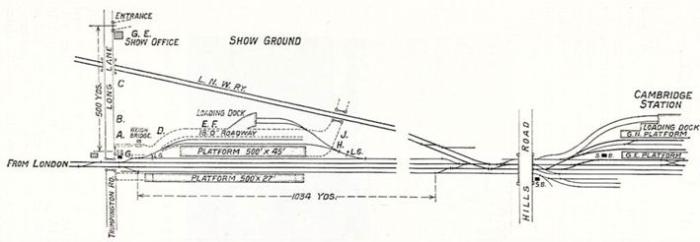
All of these facilities were installed for a few days use and then mostly stripped out. The use of the facilities was planned like a military operation and the staff provided to suit. Few trains were stabled on site and trains came from all over the country. Southbound passenger trains were sent on to [Northumberland] Park for servicing and turning round, northbound trains sent to Whittlesea or Norwich (Crown Point). Twenty five livestock trains alone were scheduled to arrive in a period of 21 hours, apart from long distance trains from as far as Manchester (via Lincoln) on a day trip. Special trains were provided locally to visit and return from the site. Such an operation would take several years to action these days and all this was done without the aid of any computers, etc! For a full report read the article in The Railway Magazine of that year. See also Disused Stations.
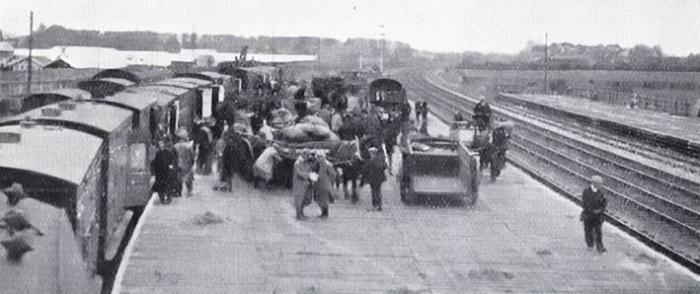
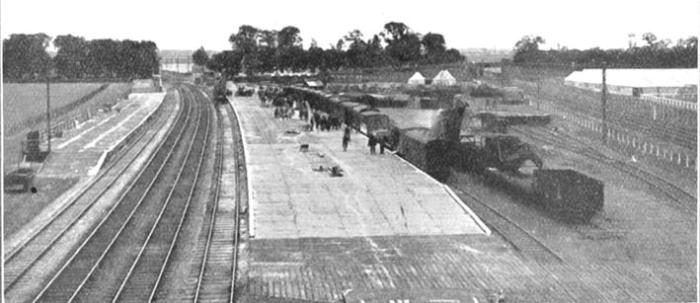
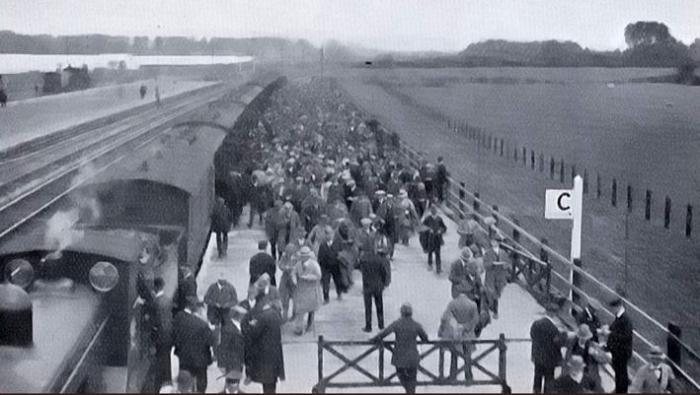
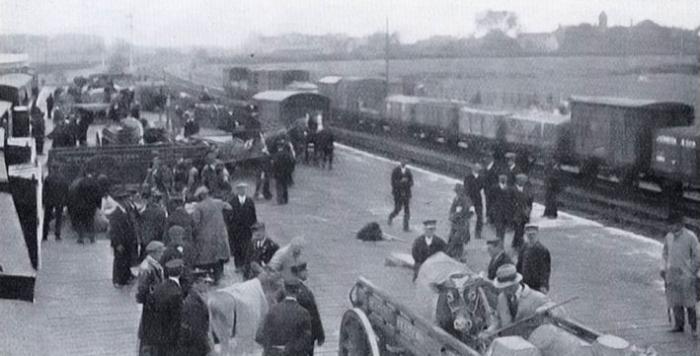
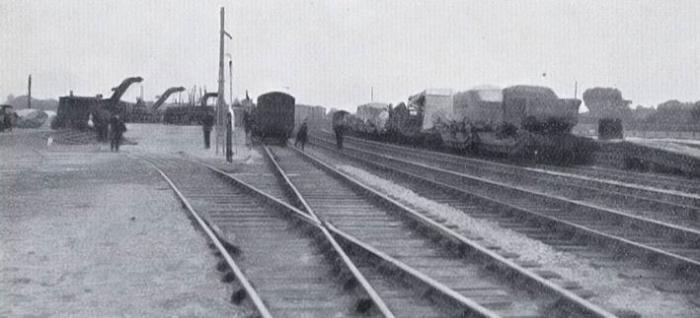
The Effects of the 1923 Grouping
After the first amalgamations to form railways such as the GER and LNWR, schemes to seriously amalgamate railways did not start to gestate until towards the turn of the 19th-20th centuries. One involved the GER and GNR with the Great Central Railway. Despite obvious advantages, Parliament did not look favourably on these plans and until the LNWR/L&YR amalgamation of 1922 none came to fruition. As mentioned in the introduction, the 1923 amalgamations were forced on the railways by Parliament who also looked even then at nationalisation. So far as Cambridge was concerned, the GER and GNR combined which meant the small GNR engine shed could be closed but there were few other manifestations. The LNWR goods yard at the corner of Brooklands Avenue and Hills Road remained (where Pordiges subsequently had their depot).
The Kings Cross services remained distinct, often being hauled by engines being run-in from Kings Cross after overhaul, including the famous Cambridge Buffet Car Expresses (known as Beer Trains to generations of Cambridge students) were very successfully introduced on a 2 hourly basis. The Royal Train continued to run from Wolferton (for Sandringham) to and from Kings Cross to avoid unnecessary procedures when the Monarch entered the City of London at Temple Bar.
The Second World War brought further strains to the railway system with the vast quantities of materials being brought to build the many airfields in East Anglia. The land between the London and Bedford lines north of Long Road was completely filled with an additional down loop (which I saw used once) and a series of sidings for wagon sorting and storage. This was effectively started after the 1922 Royal Show. After World War II, the usage dropped and by the early 1960s they were effectively out of use except that I once saw them full of old 16T mineral wagons. A west to north curve, still visible, was built at Sandy to create the M25 of the railways.
To increase line capacity what were called IBS (Intermediate Block Signals) worked automatically were installed between signal boxes. One was installed in each direction between Trumpington and Shepreth Branch Junction as this line was very heavily trafficked with trains for both London termini.
Nationalisation and Rationalisation
World War II had the same effect on the railway system as World War I. The railways were run by a Railway Executive directed by the Government, and they were only really returned to full private operation as the railways’ nationalisation loomed. Taking effect from 1 January 1948, there were little obvious changes to the Trumpington lines except for re-liverying – Eastern Region green and London Midland crimson red. However the rationalisation of transport facilities (not all of which can be blamed on Dr Beeching) inevitably lead to changes.
Dieselisation meant that the weekly Sunday train of dead locos from Stratford to Doncaster which I remember (when we got home from Church) were no more. The Haverhill/Colchester line shut and the ubiquitous Class E4 2-4-0 tender locos which dated back to the GER days were withdrawn. Surprisingly, freight facilities on the Bedford line were withdrawn before passenger services, the former on 18 April 1966 and the latter on 1 January 1968. I have a slide of a Bedford train from the Church tower ploughing its lonely way across the PBI land. Surprisingly in 1955 the Oxford-Cambridge line had been identified for development as an outer London ring for freight traffic. It is just possible that that may yet come to pass. While flyovers were built at Bletchley and rebuilt at Sandy it was all wasted.

The rundown continued with local freight services being withdrawn south of Cambridge. The nadir was probably reached in the early 1980s despite a healthy development of long-distance London commuter traffic. At long last, investment in electrification recommenced. The Liverpool Street-Bishop Stortford scheme of 1958 had enticingly continued about 1 mile north of Bishops Stortford. In 1968 the Cambridge main line down the Lea Valley had been electrified from Cheshunt to Clapton/Hackney, but further work was piecemeal. The Kings Cross-Royston line was electrified in 1976 with an hourly DMU shuttle to Cambridge. Bishops Stortford to Cambridge was completed in 1988 followed by Royston-Cambridge and Cambridge-Kings Lynn in 1990. The latter coincided with the abolition of Trumpington Signal Box and the opening of the large NX(Entry/Exit) Panel Signalling centre at Cambridge which controls all the lines from Stansted to near March.
There are now 7 trains each way per hour along the London line out of the peak and 12 in the peak hours, quite some service.
The Tramway
A tramway was used in the coprolite workings and this then ran up the ramp to the loading bank beside the A10. Long disused, the bank was removed in the 1960’s leaving the concrete bund free standing. This was demolished/blown up by the Engineer Wing of the Cambridge University Officer Training Corps in early 1970, an exercise which nearly went badly wrong and a friend of mine was quite seriously injured in the incident. Nothing now remains. As I said, at one time there was a siding off the Bedford Line, but not where a ‘Trumpington’ Ground Frame was located (referred to in Simpson (1983).
Garden Railways
I am aware of three garden or miniature railways (two of which are extant and one has a web site). As they are on private property I will not reveal other details, except to show a picture of the 7¼” passenger carrying Trumpington Miniature Railway.
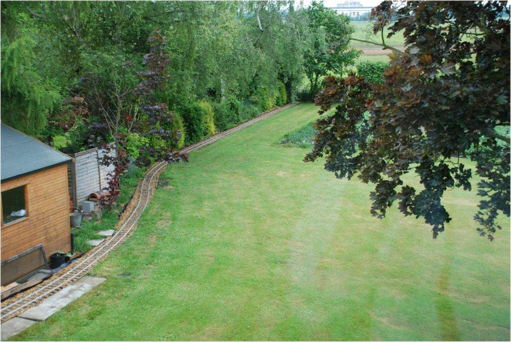
Railway status, late 2010
There are regular but infrequent block freight train services through Trumpington. Stone trains to Harlow, Hoddesdon and Freightliner/Intermodal trains from London to the Midlands and north, but no pick-up services. Some container trains from London to Felixstowe pass and then travel via Newmarket. This avoids a bottleneck around Stratford and is one reason why the Rail Freight Group want access to Cross Rail for intermodal trains! Also, if the GN Main line is blocked between Hitchin and Peterborough trains can be diverted via Cambridge (with suitable pilots). If there are engineering works, Hull Trains regularly come to and terminate at Cambridge, passengers then transfer to First Capital Connect. Given both are owned by the same company it is probably not surprising.
Though the Up Goods loop to Trumpington Box was lifted years ago, the Down Goods Loop has now been signalled for passenger trains to ease congestion south of the Station. It is possible for a train to run into Platform 1 from the south and be stationary ahead of a train in front which has run into Platforms 2 or 3!
The passenger service has been transformed from a 2-hourly train to Liverpool Street with a Buffet Car Express in the intervening hour to Kings Cross, supported by bi-hourly stopping services operated by 1st Generation DMUs. Cambridge now has 2 express, 2 semi-fast and 2 stopping trains an hour – all to London, coupled with an hourly 2nd Generation DMU train from Birmingham to Stansted Airport. That makes seven trains each way each hour off peak on the lines through Trumpington. Obviously the Bedford Line is no more and cannot be and I will pass no comment on the Guided Bus. There is occasionally talk of a station for Addenbrooke’s Hospital and while it would be very sensible it would need feeder services to make it worthwhile and the line occupation there is now so intense that relief loops would surely be required. Long Road bridge was built for and still has space for 4 tracks.
Both the Guided Bus and Addenbrooke’s Road bridges allow for a third railway track on the west side, if it is ever felt necessary to provide a separate track from Cambridge to Shepreth Branch Junction. It would however have to be signalled for reversible working, with some high speed crossovers at Shelford to make it worthwhile.
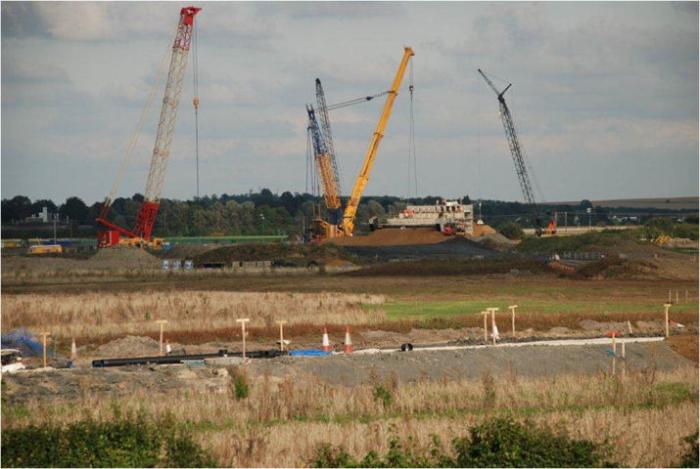
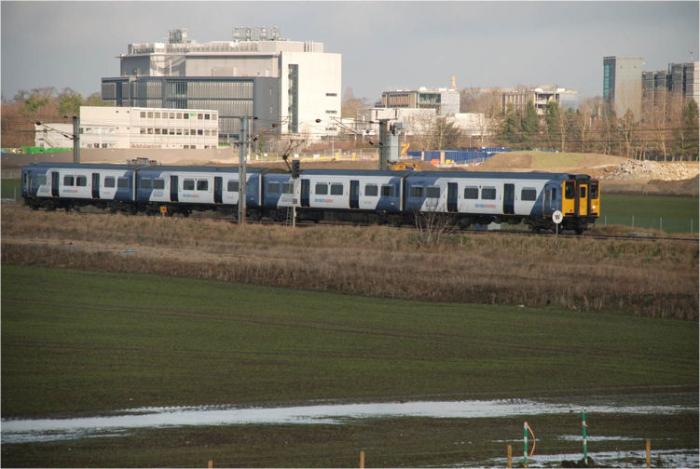
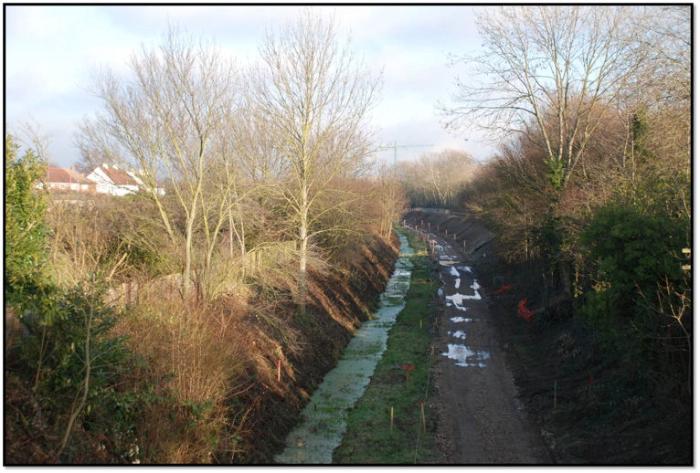
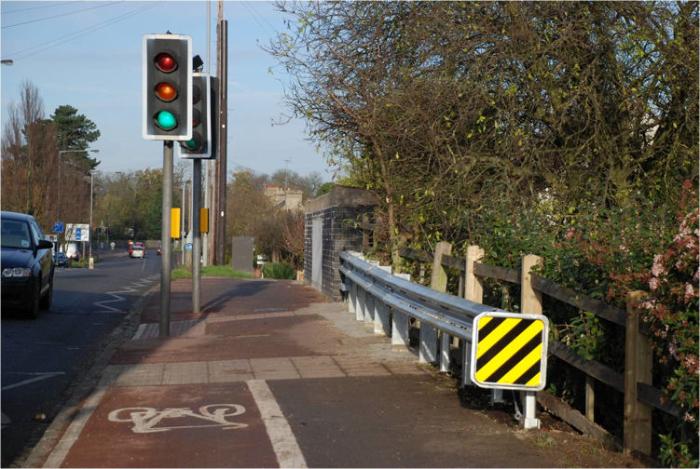
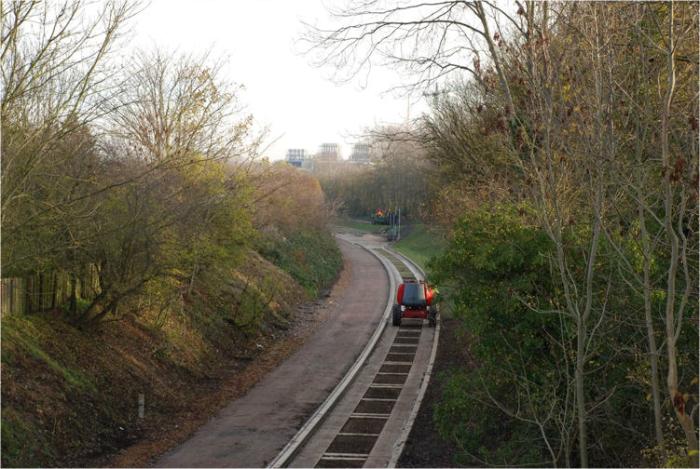
Acknowledgements
Thanks to Stephen Brown and Nick Pygott, Editor, The Railway Magazine.
Sources
Allen, Cecil J. (1955). Great Eastern Railway. Ian Allan.
Bonavia, Michael R. (1995). The Cambridge Line. Shepperton: Ian Allan.
Fellows, Reginald B. (1976). London to Cambridge by Train 1845-1938. The Oleander Press.
Grinling, Charles H. (1898). History of the Great Northern Railway. George Allen & Unwin.
Simpson, William (1983). Oxford to Cambridge Railway. Vol. 2: Bletchley to Cambridge.
Poole: Oxford Publishing.
Railway Magazine – Various volumes